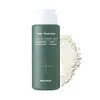What's inside
What's inside
 Key Ingredients
Key Ingredients

No key ingredients
 Benefits
Benefits

 Concerns
Concerns

 Ingredients Side-by-side
Ingredients Side-by-side

Zea Mays Starch
AbsorbentSodium Cocoyl Glycinate
CleansingPotassium Myristate
EmulsifyingPullulan
Sodium Polyacrylate
AbsorbentBetaine
HumectantMelaleuca Alternifolia Leaf Oil
AntioxidantChromium Oxide Greens
Mannitol
HumectantPapain
Skin ConditioningWater
Skin ConditioningBromelain
Skin Conditioning4-Terpineol
MaskingGlycerin
HumectantLactobacillus Ferment
Skin ConditioningMelaleuca Alternifolia Leaf Water
Antimicrobial1,2-Hexanediol
Skin ConditioningButylene Glycol
HumectantMelaleuca Alternifolia Leaf Extract
PerfumingGlycine
BufferingGlutamic Acid
HumectantAspartic Acid
MaskingSodium Chloride
MaskingHistidine
HumectantSerine
MaskingArginine
MaskingThreonine
Alanine
MaskingProline
Skin ConditioningAcrylates/C10-30 Alkyl Acrylate Crosspolymer
Emulsion StabilisingMagnesium Chloride
Calcium Chloride
AstringentZea Mays Starch, Sodium Cocoyl Glycinate, Potassium Myristate, Pullulan, Sodium Polyacrylate, Betaine, Melaleuca Alternifolia Leaf Oil, Chromium Oxide Greens, Mannitol, Papain, Water, Bromelain, 4-Terpineol, Glycerin, Lactobacillus Ferment, Melaleuca Alternifolia Leaf Water, 1,2-Hexanediol, Butylene Glycol, Melaleuca Alternifolia Leaf Extract, Glycine, Glutamic Acid, Aspartic Acid, Sodium Chloride, Histidine, Serine, Arginine, Threonine, Alanine, Proline, Acrylates/C10-30 Alkyl Acrylate Crosspolymer, Magnesium Chloride, Calcium Chloride
Water
Skin ConditioningMyristic Acid
CleansingButylene Glycol
HumectantStearic Acid
CleansingPotassium Hydroxide
BufferingGlycerin
HumectantPalmitic Acid
EmollientGlycol Distearate
EmollientLauric Acid
CleansingSodium Lauramido Diacetate
CleansingSodium/Mea-PEG-3 Cocamide Sulfate
CleansingCitrus Aurantium Dulcis Fruit Extract
MaskingOlea Europaea Fruit Oil
MaskingSorbitan Stearate
EmulsifyingLauramide DEA
 Reviews
Reviews

Ingredients Explained
These ingredients are found in both products.
Ingredients higher up in an ingredient list are typically present in a larger amount.
Butylene Glycol (or BG) is used within cosmetic products for a few different reasons:
Overall, Butylene Glycol is a safe and well-rounded ingredient that works well with other ingredients.
Though this ingredient works well with most skin types, some people with sensitive skin may experience a reaction such as allergic rashes, closed comedones, or itchiness.
Learn more about Butylene GlycolGlycerin is already naturally found in your skin. It helps moisturize and protect your skin.
A study from 2016 found glycerin to be more effective as a humectant than AHAs and hyaluronic acid.
As a humectant, it helps the skin stay hydrated by pulling moisture to your skin. The low molecular weight of glycerin allows it to pull moisture into the deeper layers of your skin.
Hydrated skin improves your skin barrier; Your skin barrier helps protect against irritants and bacteria.
Glycerin has also been found to have antimicrobial and antiviral properties. Due to these properties, glycerin is often used in wound and burn treatments.
In cosmetics, glycerin is usually derived from plants such as soybean or palm. However, it can also be sourced from animals, such as tallow or animal fat.
This ingredient is organic, colorless, odorless, and non-toxic.
Glycerin is the name for this ingredient in American English. British English uses Glycerol/Glycerine.
Learn more about GlycerinWater. It's the most common cosmetic ingredient of all. You'll usually see it at the top of ingredient lists, meaning that it makes up the largest part of the product.
So why is it so popular? Water most often acts as a solvent - this means that it helps dissolve other ingredients into the formulation.
You'll also recognize water as that liquid we all need to stay alive. If you see this, drink a glass of water. Stay hydrated!
Learn more about Water